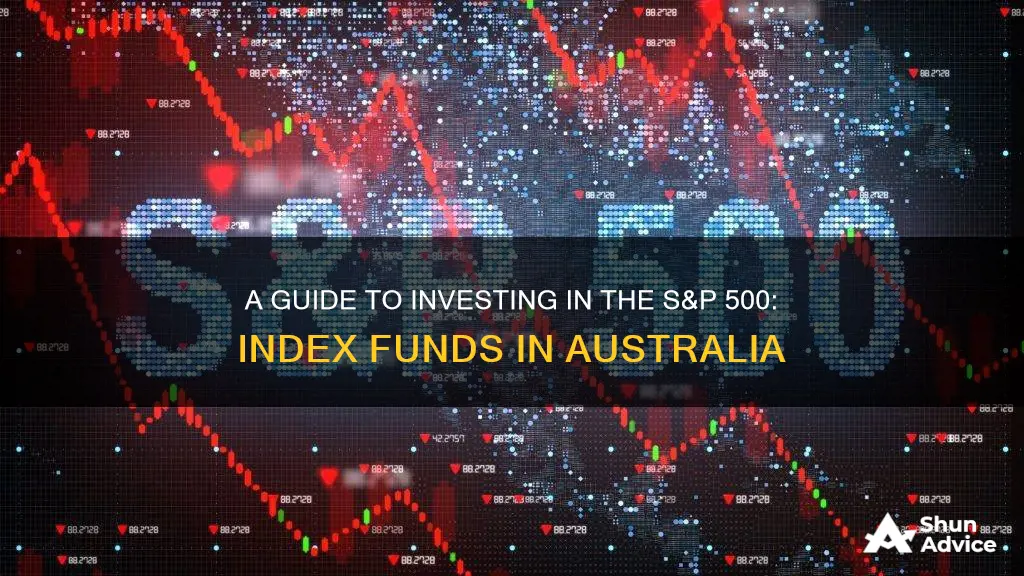
The S&P 500 index is a stock market index of the largest 500 companies listed in America, including household names like Apple, Amazon, Microsoft and Tesla. It is one of the most popular indices for investors to track the performance of the US stock market.
For Australians, there are two main ways to invest in the S&P 500: either by purchasing shares in the individual companies that make up the index, or by investing in an S&P 500 index fund or exchange-traded fund (ETF).
Investing in an S&P 500 index fund or ETF is the simplest way to gain exposure to the index. These funds aim to replicate the returns of the S&P 500 by tracking its performance, offering investors a diversified portfolio of US large-cap companies without the effort of purchasing individual stocks.
To invest in an S&P 500 index fund or ETF, you will need to open a brokerage account with access to US securities and deposit funds. You can then purchase shares in the fund, either by setting a buy price or using a market order.
Some popular S&P 500 ETFs available in Australia include:
- iShares S&P 500 ETF (ASX: IVV)
- iShares S&P 500 AUD Hedged ETF (ASX: IHVV)
- SPDR S&P 500 ETF Trust (ASX: SPY)
- BetaShares S&P 500 Equal Weight ETF (QUS)
| Characteristics | Values |
|---|---|
| What is the S&P 500? | The S&P 500, or the Standard & Poor's 500, is an index representing 500 of the largest US companies, measured by market capitalisation. |
| How to invest in the S&P 500? | You can invest in the S&P 500 by choosing an Australian-listed ETF that tracks the index on the ASX or by opening an investing account with access to US markets to invest in US-listed S&P 500 funds or ETFs. |
| Advantages of investing in the S&P 500 | Stability and quality, diversification, dividends, strong historical performance. |
| Disadvantages of investing in the S&P 500 | Limited exposure to small-cap stocks, market cap bias, overwhelming diversity. |
| Best time to invest in the S&P 500 | There is no "best time" to invest. It is recommended to dollar-cost average (i.e. top up your investments regularly). |
| Best S&P 500 ETFs in Australia | iShares Core S&P 500 ETF ($IVV), SPDR S&P 500 ETF Trust ($SPY), BetaShares S&P 500 Yield Maximiser Fund ($UMAX). |
What You'll Learn

Choose a broker that offers US stocks or S&P 500 exchange-traded funds (ETFs)
To invest in the S&P 500, you will need to choose a broker that offers US stocks or S&P 500 ETFs. There are several brokers available that provide access to these investments, so you can choose the one that best suits your needs. Here are some factors to consider when selecting a broker:
- Account requirements and fees: Check if there are any minimum deposit requirements or account fees. Some brokers may charge a commission on trades, while others offer commission-free trading.
- Investment options: Look for a broker that offers a wide range of investment options, including US stocks and S&P 500 ETFs.
- Tools and research: Consider the tools and research materials provided by the broker. Some brokers offer extensive research and analysis tools, while others provide more basic information.
- Customer support: Choose a broker with a strong customer support system that can assist you with any questions or issues you may have.
- User-friendliness: Opt for a broker with a user-friendly platform that is easy to navigate and use.
Once you have considered these factors, you can open an account with your chosen broker and start investing in the S&P 500.
Schwab S&P 500 Index Fund: A Smart Investment Choice
You may want to see also

Provide ID and fund your account
To get started with investing in the S&P 500, you'll need to choose a broker that offers either US stocks or S&P 500 exchange-traded funds (ETFs). Once you've done that, you can provide your ID and fund your account.
The exact steps will depend on the broker you choose, but here are some general guidelines:
- Sign up for an account: Visit the website of your chosen broker and look for an option to sign up or create an account. You'll usually need to provide personal information such as your name, email address, and country of residence. You may also need to create a username and password.
- Verify your identity: As part of the sign-up process, you will likely be asked to verify your identity. This is a standard procedure to prevent fraud and ensure the security of your account. You may be asked to provide documents such as a passport, driver's license, or utility bill.
- Fund your account: After your account has been created and verified, you'll need to add funds to it. This can typically be done through a bank transfer, debit card, or other payment methods offered by the broker. The specific steps will vary depending on the broker's platform, but there should be clear instructions on how to deposit funds.
- Review the broker's requirements: Before you start investing, make sure you understand the broker's requirements and any associated fees. Some brokers may have minimum deposit amounts, transaction fees, or other charges. It's important to familiarise yourself with these details to avoid any surprises later on.
Remember to do your research and choose a reputable broker that suits your investment goals and strategy. Different brokers may offer different features, so it's essential to compare their platforms, fees, and services before making a decision.
Finding Mutual Fund Managers: Where Do They Invest?
You may want to see also

Research different ETFs and stocks available and compare prices
When researching and comparing the prices of different ETFs and stocks, it is important to consider the following factors:
Fees and Costs
ETFs are generally considered a low-cost investment option, but it is important to evaluate the different fees and costs associated with each fund. Some common fees to look out for include management fees, transaction costs, and expense ratios. Compare these fees across different ETFs to find the most cost-effective option.
Performance and Returns
Consider the historical performance and returns of the different ETFs and stocks. Look at their long-term track record and how they have performed during different market conditions. While past performance does not guarantee future results, it can give you an idea of the fund's potential.
Investment Goals and Strategy
Different ETFs and stocks may align with different investment goals and strategies. Some funds may focus on growth, income generation, or diversification. Choose the funds that align with your investment objectives and risk tolerance.
Diversification
Consider the level of diversification offered by the ETF or stock. The S&P 500 already provides exposure to a diverse range of large-cap US companies across various sectors. However, you may also want to consider investing in funds that provide exposure to small-cap stocks or other markets to further diversify your portfolio.
Liquidity
Look at the liquidity of the different ETFs and stocks. This refers to how easily you can buy or sell the investment without impacting the market price. Funds with higher trading volumes tend to be more liquid, making it easier to enter or exit a position.
Dividends
Many companies in the S&P 500 pay regular dividends, which can provide a steady income stream for investors. Compare the dividend yields offered by different ETFs and stocks to find the most attractive option.
Risk and Volatility
Consider the level of risk and volatility associated with each investment option. Some funds may be more volatile and carry higher risks, while others may offer more stable and consistent returns. Choose the funds that align with your risk tolerance and investment horizon.
Currency Risk
For Australian investors, currency exchange risk is an important consideration when investing in US-based ETFs or stocks. Look for funds that hedge against currency fluctuations to mitigate this risk.
Fund Size and Reputation
Consider the size and reputation of the fund provider. Larger funds tend to have better liquidity and lower trading costs. Additionally, research the track record and reputation of the fund provider to assess their reliability and expertise.
Tax Implications
Different investment options may have varying tax implications. Consider the potential tax consequences of each investment option and how they align with your financial situation and goals.
Remember to conduct thorough research and compare multiple options before making any investment decisions. Diversifying your portfolio across different ETFs and stocks can help manage risk and maximise your potential returns.
A Beginner's Guide to Index Fund Investment on E-Trade
You may want to see also

Select your S&P 500 index fund or stocks
You can choose to buy all 500 stocks or invest in an S&P 500 index fund. The easiest way to do this is through an online share trading platform. Here are the steps to follow:
- Choose a broker that offers either US stocks or S&P 500 exchange-traded funds (ETFs).
- Provide ID and fund your account.
- Research the different ETFs and stocks available and compare prices.
- Select your S&P 500 index fund or stocks.
- Purchase your ETF or stocks by setting a buy price or using a "market order".
If you're looking to buy individual stocks on the S&P 500, here are some steps to follow:
- Find a broker that allows you to invest in the S&P 500.
- Do your research. If you're going to buy an individual share or a basket of shares, you should understand the ins and outs of the business you want to own.
- Deposit funds. You'll need to add funds to your account before you can buy any shares.
- Buy the index fund. Once your money has been deposited, you can then buy stocks in the S&P 500. You'll generally pay a small annual commission fee and foreign exchange fee when you trade US stocks.
- Review. Once you've purchased the stocks, keep an eye on the business's performance.
If you're looking to invest in an S&P 500 index fund, here are some steps to follow:
- Find an S&P 500 index fund. Some index funds track the performance of all 500 S&P stocks, while others only track a certain number of stocks or are weighted more towards specific stocks. Do your research before deciding which is best for you.
- Open a share trading account. To invest in an S&P 500 ETF, you'll need to open a trading account with a broker or an online share trading platform.
- Deposit funds. You'll need to deposit funds into your account to begin trading.
- Buy the index fund. Once your money has been deposited, you can then buy units in the S&P 500 index fund, the same as you would buy stocks. You'll generally pay a small annual fee (called the MER fee) to the ETF fund manager, which is taken out of your returns.
- IShares S&P 500 AUD Hedged ETF: (IHVV)
- IShares S&P 500 ETF:L (IVV)
- BetaShares S&P 500 Equal Weight ETF (QUS)
- SPDR S&P 500 ETF Trust: (SPY)
- BetaShares S&P 500 Yield Maximiser Fund (Managed Fund): (UMAX)
- ETFS S&P 500 High Yield Low Volatility ETF: (ZYUS)
HOA Fund Investment Strategies: A Guide to Smart Investing
You may want to see also

Purchase your ETF or stocks
Once you've chosen a trading platform or broker, you'll need to sign up for an account. It's generally free to sign up, and most platforms let you sign up online or via an app. However, you'll need to provide some personal information and documentation during the sign-up process, including your name, address, date of birth, contact details, tax file number, and bank account details.
After signing up, you'll need to fund your account. This can be done through a bank transfer, debit card, or even Apple/Google Pay. Once your account is funded, you can start searching for the ETF or stocks you want to purchase. You can do this by searching for the name or ticker symbol of the asset. It's important to do your research to ensure that the investment aligns with your financial goals and risk tolerance.
When you're ready to make a purchase, you can select the amount you want to buy. You can choose to buy a specific number of shares or a total dollar amount. You'll also need to choose your order type, either a market order, where you buy at the current price, or a limit order, where you set the price you want to buy at.
Finally, review the details of your order and confirm the purchase. It's important to keep in mind that investing carries risks, and you may lose money. Be sure to do your research and understand the risks involved before making any investments.
Arbitrage Funds: Smart, Safe, and Profitable Investment Strategy
You may want to see also
Frequently asked questions
The S&P 500, or Standard & Poor's 500, is a stock market index that measures the performance of 500 large US companies. It is often considered a bellwether for the overall health of the US stock market.
There are a few ways to invest in the S&P 500 in Australia. One way is to purchase shares in exchange-traded funds (ETFs) that track the S&P 500. Another way is to invest in index funds, which are designed to replicate the performance of the index. You can also use online trading platforms that offer access to US securities.
Investing in the S&P 500 offers a few potential benefits. Firstly, it provides exposure to a diversified portfolio of large-cap US companies. Secondly, the S&P 500 has historically delivered strong long-term returns, outperforming many other investment options. Additionally, the S&P 500 is considered a relatively safe investment option due to the stable growth and consistent returns provided by the large, high-quality companies that comprise the index.
While investing in the S&P 500 can be a good option, there are also some risks to consider. One risk is that the S&P 500 focuses exclusively on large-cap companies, potentially missing out on the higher growth potential of smaller companies. Additionally, the index's reliance on market capitalisation for weighting can skew its returns, especially in market environments where mega-cap stocks perform disproportionately well or poorly compared to the broader market.







